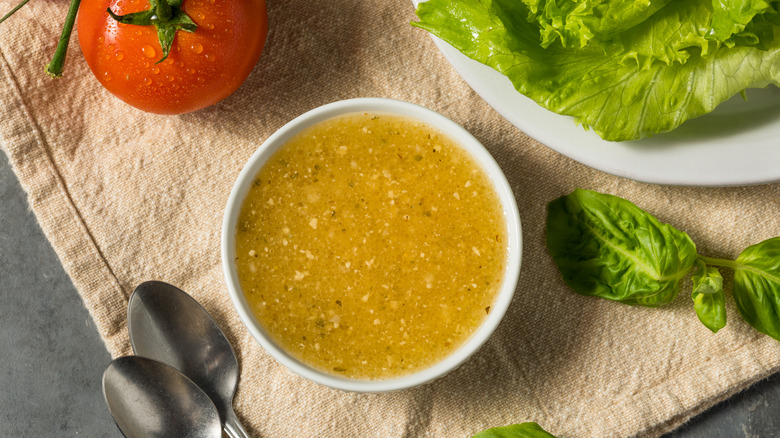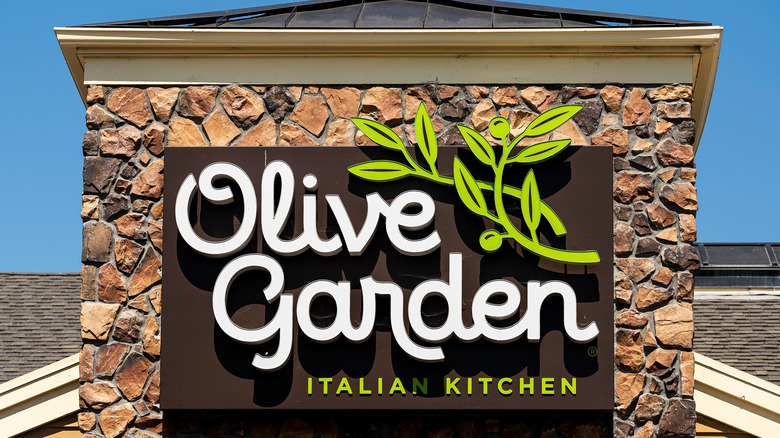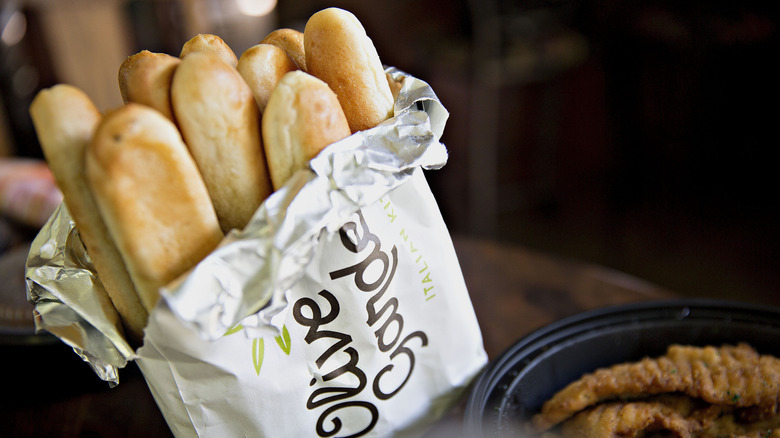Why Olive Garden's Signature Salad Dressing Isn't Really Italian
Olive Garden is arguably the most successful sit-down chain restaurant in America. Even if they've served alcohol to children multiple times, they're still ranked either one or two in total sales among full-service chain restaurants depending on the year (Applebee's is the only other chain that appears to be in their league). And why wouldn't Americans go nuts for them? The never-ending pasta bowl is a staple, and when the company sold a never-ending pasta pass a few years back, it sold out in literal milliseconds.
It probably also won't surprise you to learn that Olive Garden is far from authentically Italian. Yes, it's true: The company originally founded by General Mills with no Italians involved in the process, which once tried to pass "pastachetti" off as an authentic dish, isn't really Italian. For shame.
But the ways in which Olive Garden isn't authentic extend from there. In particular, one of their signature products is way off the mark — their "Italian" salad dressing. Not only is Olive Garden's Italian dressing not really Italian, but you won't find anything even remotely like it on an Italian menu.
Italians don't eat anything resembling Italian dressing
Since being introduced on store shelves in 2012, Olive Garden's Italian dressing — the same as what's sold in the restaurant itself — has sold like gangbusters. It was initially intended to be on store shelves for only a year — but proved so popular that they couldn't pull it from shelves. But you won't find anything remotely like it in Italy.
It's not that Italians don't eat salad — it's a popular and in many cases mandatory part of the dinner experience. Italians, though, typically consume light vinaigrette dressings that just consist of olive oil, vinegar (typically either red wine or balsamic), salt, and pepper — the idea here being that the dressing shouldn't overpower the salad and become the only thing you're tasting. Olive Garden's dressing, meanwhile, consists of soybean oil, distilled white vinegar, eggs, Romano cheese, salt, black pepper, dehydrated garlic, and other processed food throw-ins like xantham gum and dextrose. You will notice that other than salt and pepper, the two don't share a single ingredient since Olive Garden's version doesn't even use the right kind of vinegar — or, ironically, olive oil.
Olive Garden's inauthentic ways are myriad
The list of ways in which Olive Garden misses the mark on actual Italian food. "Chicken fettuccine Alfredo" is a dish that doesn't exist anywhere in Italy since Italians eat meat and pasta courses separately from each other. Yes, this means spaghetti and meatballs don't exist in Italian cuisine — oh, and their Italian meatballs tend to be much smaller than what we're used to here, as well.
Most significantly for American audiences, their signature breadsticks — aka the thing everyone associates with Olive Garden — don't even remotely resemble the Italian version. Italians do eat breadsticks, but they're not soft; they're called "grissini," and they're hard enough to snap in half and possibly crack a tooth on. They're so hard that the NHS in the UK actually recommends using them for teething babies (per the NHS).
Still, even if Olive Garden isn't anything like actual Italian food, they're clearly doing something right for the American audience. Their popularity isn't going away any time soon — whether it's authentic or not.


